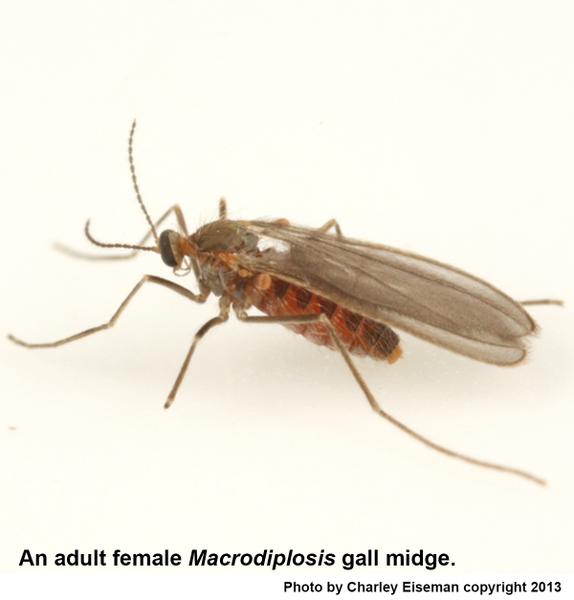Description and Biology
Midges in the genus Macrodiplosis cause vein "pocket" galls on the leaves of oaks. These galls appear much like some of the leaf galls of cynipid gall wasps, but when the galls are opened, the maggots inside each have a peculiar "breast bone" structure typical of cecidomyiid larvae. Gall midge maggots drop from the galls to pupate in the soil in a thin, silken cocoon. The following year, a new generation of tiny, mosquito-like gnats emerges from the soil to lay eggs on the developing buds of oaks in early spring. It is not unusual for insect populations to fluctuate drastically from year to year and place to place. Next year the galls may not show up at all. On the other hand, they may be worse!
Host Plants
Macrodiplosis maggots cause galls along leaf veins of red oaks although some species can cause pocket galls on the leaf margin. This type of gall midge injury usually does little harm to oak trees unless the galls cause more than 50% of the leaves to drop prematurely early in the growing season. Most of the time, Macrodiplosis gall midges cause more alarm than real harm to the overall health of a tree..
Residential Recommendation
By the time symptoms are noticed, it is usually too late to apply an insecticide to kill the maggots inside the gall. If chemical control is desired for the next year, consider spraying the tree with some sort of contact/systemic pesticide such as acephate or imidacloprid just as the buds are breaking in early spring.
References
- Celticecis, a Genus of Gall Midges (Diptera: Cecidomyiidae), Newly Reported for the Western Palearctic Region. Gagné, Raymond J.; Moser, John C. 1997. Proceedings of the Entomological Society of Washington 99(4): 756
- Gall midges (Diptera: Cecidomyiidae) of South Tyrol (Italy) - summary of results and zoogeographical analysis. Marcela Skuhravá, M. and V. Skuhravý. 2010. Gredleriana 10: 275 - 324.
- Vein Pocket Gall, Macrodiplosis quercusoruca. Anonymous. No Date. Entomology and Plant Pathology Digital Diagnostics. Div. Agr. Sci. & Nat. Resources, Oklahoma State Univ.
- Insect and Related Pests of Shrubs
- Extension Plant Pathology Publications and Factsheets
- Horticultural Science Publications
- North Carolina Agricultural Chemicals Manual
For assistance with a specific problem, contact your local N.C. Cooperative Extension Center.
This Factsheet has not been peer reviewed.
Publication date: May 16, 2014
Reviewed/Revised: Oct. 1, 2019
Recommendations for the use of agricultural chemicals are included in this publication as a convenience to the reader. The use of brand names and any mention or listing of commercial products or services in this publication does not imply endorsement by NC State University or N.C. A&T State University nor discrimination against similar products or services not mentioned. Individuals who use agricultural chemicals are responsible for ensuring that the intended use complies with current regulations and conforms to the product label. Be sure to obtain current information about usage regulations and examine a current product label before applying any chemical. For assistance, contact your local N.C. Cooperative Extension county center.
N.C. Cooperative Extension prohibits discrimination and harassment regardless of age, color, disability, family and marital status, gender identity, national origin, political beliefs, race, religion, sex (including pregnancy), sexual orientation and veteran status.


